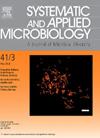从海洋沉积物中分离的一种细菌——海洋中根瘤菌的描述和基因组特征。
IF 4.2
2区 生物学
Q2 BIOTECHNOLOGY & APPLIED MICROBIOLOGY
引用次数: 0
摘要
从广西钦州湾海相沉积物中分离到2株革兰氏染色阴性好氧菌株,设计为ZMM04-4T和ZMM04-5。主要呼吸醌为泛醌-10。极性脂质鉴定为二磷脂酰甘油、磷脂酰甘油、磷脂酰胆碱、磷脂酰乙醇胺、氨基磷脂和磷脂。主要脂肪酸为C18:1ω7c、C19:0 cyclo ω8c和C16:0。菌株ZMM04-4T与ZMM04-5的16S rRNA基因序列相似性为99.7%。菌株ZMM04-4T与菌株ZMM04-5的数字DNA-DNA杂交和平均核苷酸同源性分别为92.9%和98.6%,表明菌株ZMM04-4T与菌株ZMM04-5属于同一种。系统发育和系统基因组分析表明,菌株ZMM04-4T和ZMM04-5属于中根瘤菌属,与青生基中根瘤菌CGMCC 1.12097T(97.7% ~ 97.8%)和上格里勒斯中根瘤菌DSM 21850T(97.7% ~ 97.8%)序列相似性最高。菌株ZMM04-4T、ZMM04-5与近缘种的平均核苷酸同源性和数字DNA-DNA杂交值分别在76.5% ~ 77.2%和20.9% ~ 21.8%之间,表明菌株ZMM04-4T、ZMM04-5为新种。根据系统发育、基因组学、表型和化学分类特征,菌株ZMM04-4T和ZMM04-5应归属于中根瘤菌属(Mesorhizobium marinum sp. nov.),并被鉴定为一个新种。型应变为ZMM04-4T (=MCCC 1K08883T = KCTC 8273T)。本文章由计算机程序翻译,如有差异,请以英文原文为准。
Description and genomic characterization of Mesorhizobium marinum sp. nov., a bacterium isolated from sea sediment
Two Gram-stain-negative, aerobic strains, designed ZMM04-4T and ZMM04–5, were isolated from sea sediment collected from Qinzhou Bay, Guangxi Zhuang Automous Region, China. The predominant respiratory quinone was ubiquinone-10. The polar lipids were identified as diphosphatidylglycerol, phosphatidylglycerol, phosphatidylcholine, phosphatidylethanolamine, aminophospholipid and phospholipid. The predominant fatty acids were C18:1ω7c, C19:0 cyclo ω8c and C16:0. Strain ZMM04-4T shared 99.7 % similarity of 16S rRNA gene sequence with ZMM04–5. The digital DNA-DNA hybridization and average nucleotide identity values between strain ZMM04-4T and ZMM04–5 were 92.9 % and 98.6 %, respectively, indicating that strains ZMM04-4T, ZMM04–5 belong to the same species. Phylogenetic and phylogenomic analysis indicated that strains ZMM04-4T and ZMM04–5 belong to the genus Mesorhizobium and showed the highest sequence similarity to Mesorhizobium qingshengii CGMCC 1.12097T (97.7 %–97.8 % sequence similarity) and Mesorhizobium shangrilense DSM 21850T (97.7 %–97.8 %). The average nucleotide identity and digital DNA-DNA hybridization values between strains ZMM04-4T, ZMM04–5 and their closely related species were within the ranges of 76.5 %–77.2 % and 20.9 %–21.8 %, respectively, indicating that strains ZMM04-4T, ZMM04–5 were novel species. In accordance with phylogenetic and genomic as well as phenotypic and chemotaxonomic characterizations, strains ZMM04-4T and ZMM04–5 should be assigned to the genus Mesorhizobium and indentified as a novel species, for which the name Mesorhizobium marinum sp. nov., is proposed. The type strain is ZMM04-4T (=MCCC 1K08883T = KCTC 8273T).
求助全文
通过发布文献求助,成功后即可免费获取论文全文。
去求助
来源期刊

Systematic and applied microbiology
生物-生物工程与应用微生物
CiteScore
7.50
自引率
5.90%
发文量
57
审稿时长
22 days
期刊介绍:
Systematic and Applied Microbiology deals with various aspects of microbial diversity and systematics of prokaryotes. It focuses on Bacteria and Archaea; eukaryotic microorganisms will only be considered in rare cases. The journal perceives a broad understanding of microbial diversity and encourages the submission of manuscripts from the following branches of microbiology:
 求助内容:
求助内容: 应助结果提醒方式:
应助结果提醒方式:


